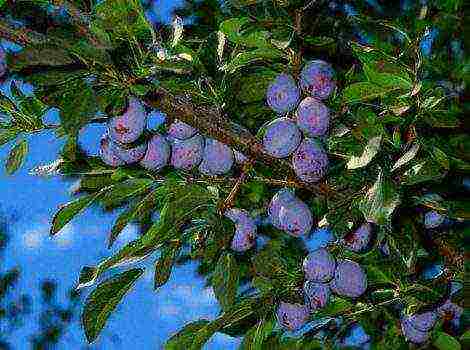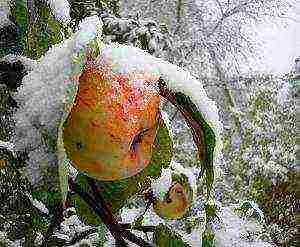Content
- 1 1. Xihu Longjing
- 2 2. Dongting Bilochun
- 3 3. Junshan Yinzhen
- 4 4. Huangshan Maofeng
- 5 5. Qi Men Hong Cha
- 6 6. Liuan Guapian
- 7 7. Taiping Houkui
- 8 8. Xinyang Maojian
- 9 9. Tie Guanyin
- 10 10. Da Hong Pao
- 11 Description and types of Chinese teas
- 12 Green tea
- 13 Brewing green tea
- 14 White tea
- 15 Properties of white tea
- 16 Yellow tea
- 17 Features of yellow tea varieties
- 18 Turquoise tea - oolong
- 19 Black tea
- 20 Puer
- 21 Bound tea
- 22 Instead of an afterword
- 23 Ten famous teas of China
- 24 About the origin of tea varieties
- 25 Sources of
August 10, 2015
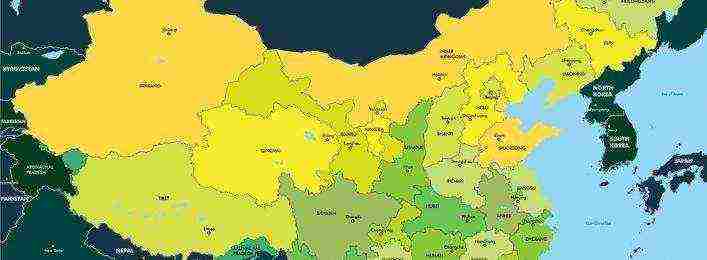
The penchant for rating did not appear in our time. For example, the list of the best sources in China was compiled back in the 8th century for the first tea encyclopedia "Cha Jing" ("The Canon of Tea"). For this three-volume opus, its author, master Lu Yu, was recognized as the patron god of the tea business.
The creators of modern top lists have not yet received such a title. Perhaps due to the fact that they cannot come to a consensus and unequivocally say which Chinese tea is known more than others. While connoisseurs argue, it remains for us to focus on those varieties that most often fall into tea ratings.
1. Green tea Si-Hu Long-Jing ("Dragon's Well from Lake Si-Hu")
It is considered the most famous variety and consistently gets into all the "dozens of tea", as well as to the table of all kinds of diplomatic missions and missions. For some reason, Dragon Well is especially popular with politicians, regardless of their ideological affiliation. It was the favorite tea of several emperors and the chairman of the Chinese Communist Party, Mao Zedong, and won the favor of Queen Elizabeth II and President Nixon. In a word, Xi-Hu Long Jing is a real statesman, and it is not for nothing that control over his quality is part of the official duties of the Chinese government.
Useful properties: tonic and restorative drink, refreshing not only the receptors, but also the attitude towards life.
Place of production: Zhejiang province.
2. Green tea Bi-Lo Chun ("Emerald spirals of spring")
If there were a beauty contest among the varieties of tea, then Bi-Lo Chun would undoubtedly come out the winner. Experts believe that it combines all four tea virtues: amazing color, graceful shape of tea leaves, bright aroma and rich taste.
Probably the secret of this cultivar's perfection is in the right neighborhood. Tea plantations are deliberately placed near fruit orchards, so that the fresh leaves of Bi-Lo Chun soak up the honey breath of flowering fruit trees.
Useful properties: promotes weight loss, normalizes blood pressure and emotional mood.
Place of production: Jiangsu province.
3. Oolong Te Gaun-Yin ("Iron Bodhisattva Kuan-Yin") 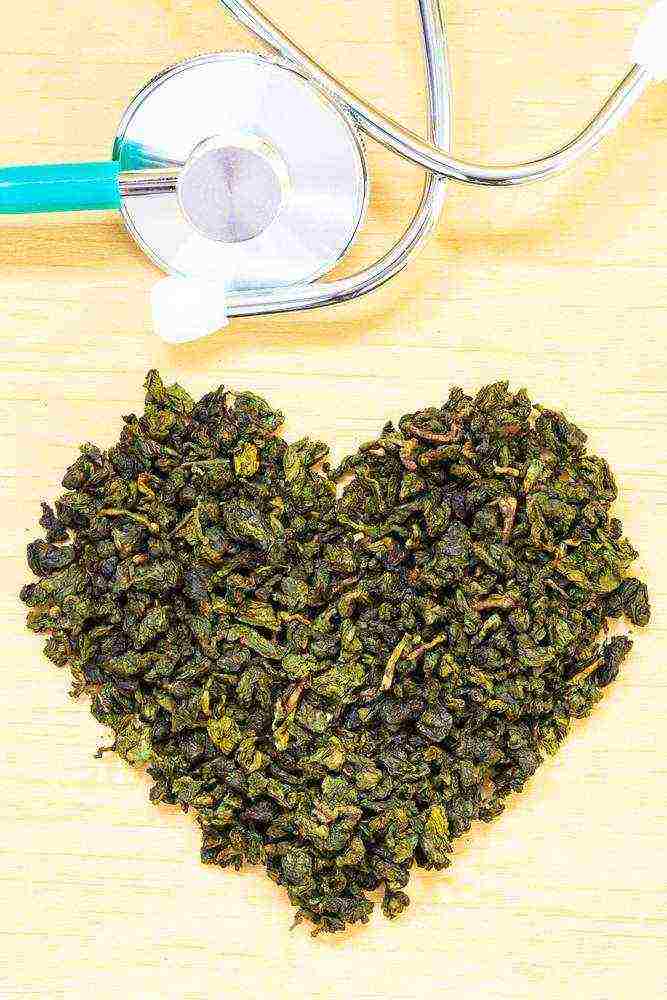
It is famous for two characteristic features: a pronounced floral aroma and the same pronounced strengthening effect on the body. Both properties are explained by the origin of this tea, which, according to legend, is the gift of the deity Kuan-Yin, the protector of people from all diseases and sorrows.
The epithet "iron" in the name of the variety characterizes the peculiarity of the tea leaves. When processed, they are rolled so tightly that they appear heavier than other tea granules.
Grown in the mountains, Tie Kuan-Yin contains a large amount of beneficial elements and minerals, so its regular use has a beneficial effect on human health and emotional balance.
Useful properties: improves mood and body resistance to various diseases, strengthens blood vessels and self-confidence.
Place of production: Fujian province.
4. Green tea Huang Shan Mao-Feng ("Fuzzy peaks from the Yellow Mountains")
The tea leaf is exceptionally sensitive to the environment. Moreover, it absorbs not only smells and tastes, but also an aesthetic component, for example, the beauty of landscapes.Don't believe me? Then try Mao Feng, the fourth position on the top of the list of famous teas. Just bend over the cup, take a breath first and then a sip - and you will see the Yellow Mountains breathing rain and the scent of orchids, proudly flying up to the clouds pierced by sun arrows and colored rainbow ribbons.
Useful properties: improves performance, has a beneficial effect on vision, including increasing the acuity of perception of beauty.
Place of production: Anhui province.
5. Oolong Da-Hong Pao ("Big Red Robe")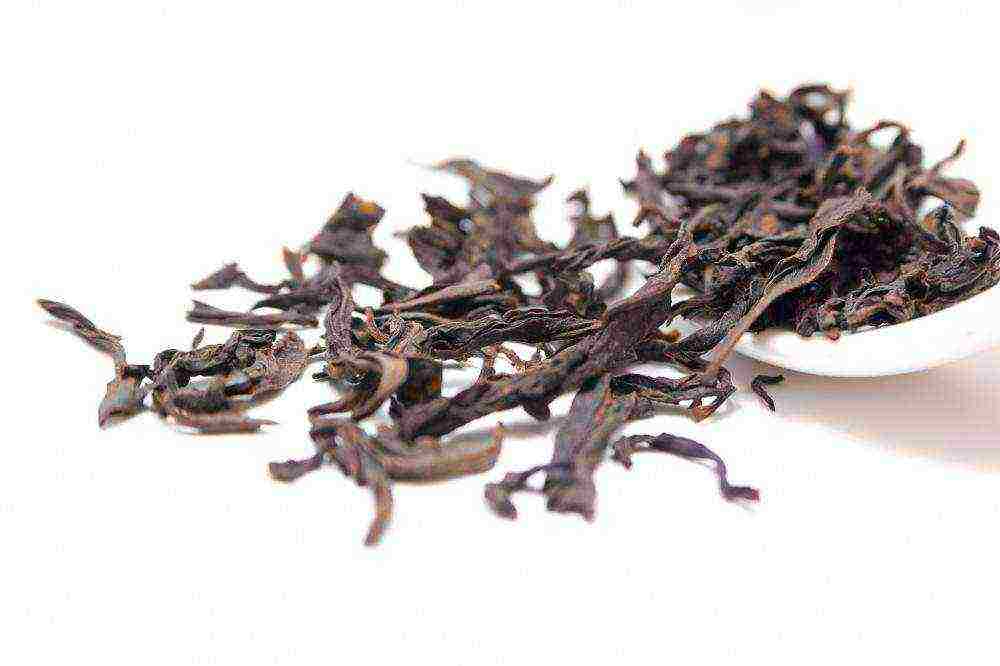
Despite the fifth line in the ranking, "Big Red Robe" is considered the king of teas.
No place colors variety!
However, one can argue with this, if we remember that Da-Hong Pao grows in the mountains of Wu. This ridge is famous for its picturesque landscapes, special soil composition and the fact that it is the cradle of neo-Confucianism. It is this combination of physical and metaphysical factors that probably explains the unique character of rock tea.
Useful properties: relieves headaches, strengthens the immune system, promotes concentration, especially on the positive aspects of life.
Place of production: Fujian province.
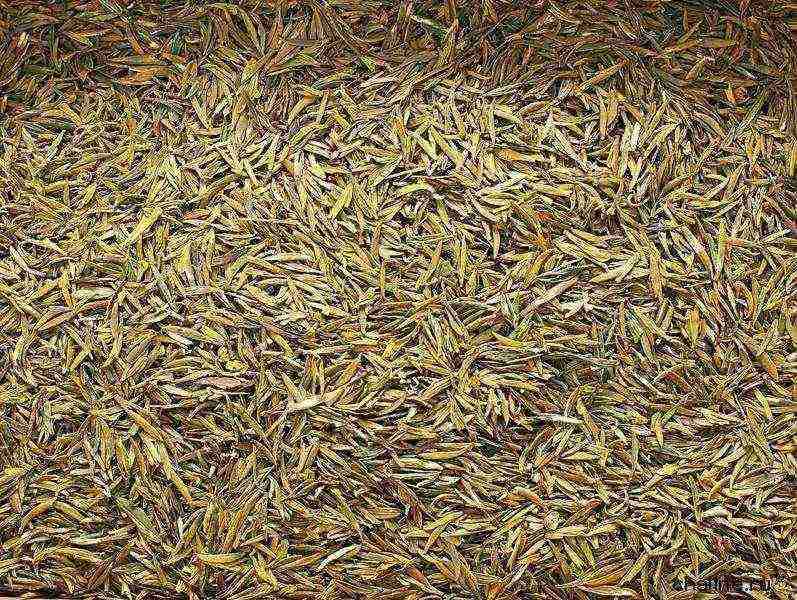 6. Yellow tea Jun Shan Yin-Zhen ("Silver needles from the Mountain of the Immortals")
6. Yellow tea Jun Shan Yin-Zhen ("Silver needles from the Mountain of the Immortals")
The variety entered the top ten known only recently, although it has been produced since the VIII century. The fact is that Yin-Zhen has long been considered the privilege of members of the imperial family. The rest were forbidden to drink this tea, and they were punished with death for selling it to foreigners.
As soon as the restriction was lifted, the world instantly gave the Silver Needles the highest rating for taste and aroma. They are really exceptional in tea, because the sprouts for its production are selected more than biasedly: the slightest flaw - and the kidney is rejected. It is clear that such a quality cannot exist in quantity, so Jun Shan Yin-Zhen continues to be tea for the elite, however, in an aesthetic rather than a class sense.
Useful properties: contains a large amount of vitamins, trace elements and catechins, thereby activating the body's strength, both physical and mental.
Place of production: Hunan province.
7. Qimen Hong Cha Gongfuhong Red Tea (Qimen Superior Red Tea)
By the standards of Chinese history, this is a young variety - it appeared only in the 19th century. However, despite his youth, Qimen Hong Cha quickly became famous, primarily due to its special aroma. Oh, what is not in it: fruity notes, floral overflows, velvety spice and ringing refreshing sourness - what a miracle it is!
This exquisite bouquet won first the jury of the World Exhibition in 1915, and then the hearts of tea connoisseurs from various countries.
Useful properties: helps to get rid of excess weight, excess stress and excess distraction, helps to concentrate and strengthen the cardiovascular system.
Place of production: Anhui province.
8. Green tea Luan Guapian ("Pumpkin seeds")
The only variety for the preparation of which only the pulp of the tea leaf is used. No petioles, let alone buds: Luan Guapian is a solid tea and, by the way, completely unlike pumpkin seeds. It doesn't look like anything at all, especially the taste: sweet but fresh; light but bright; strong, but delicate ... In a word, a real collection tea, rare, exquisite and, of course, expensive.
Useful properties: promotes mood elevation, helps to cope with insomnia, normalizes blood pressure and self-esteem.
Place of production: Anhui province.
9. Yunnan Puer ("Puer from Yunnan Province")
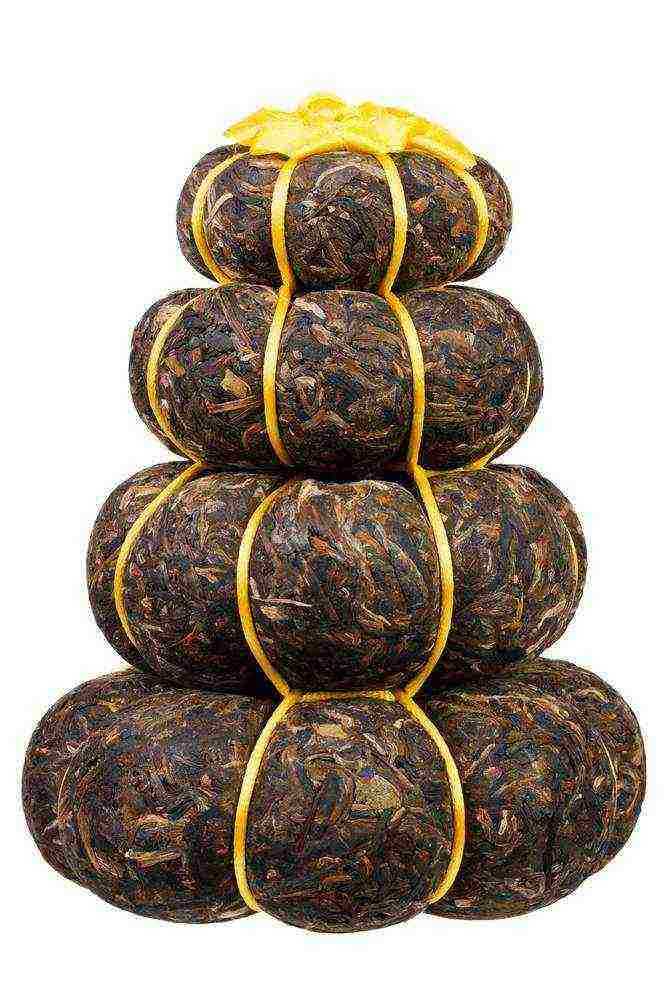
Legend claims that this tea appeared thanks to Zhuge Liang, who served as the prime minister of the Shu state during the era of the Three Kingdoms, that is, at the beginning of the 3rd century. China was then divided into three warring states and was engulfed in turmoil. It was at this difficult moment that the statesman made an invaluable gift to the people - the seeds of a plant, from the leaves of which they began to make fragrant Pu-erh tea.
By the way, Liang was also the author of the recipe.Along the way, he invented a mine, a wheelbarrow, a high-speed crossbow, something like an unmanned balloon and a dish called "mantou", similar to dumplings. He was a great man! Not surprisingly, his tea quickly became one of the most popular, first in the Middle Kingdom, and then in the world.
Useful properties: Puer perfectly invigorates and tones, improves the functioning of the gastrointestinal tract, helps to lose weight and heavy thoughts.
Place of production: Yunnan province.
10. White tea Bai-Hao Yin-Zhen ("Silver needles with white pile")
Very thin, very delicate and very expensive - this is how gourmets describe this tea. Some are less accurate, but more poetic, saying that he is "white as a cloud, green as a dream, pure as snow and fragrant as an orchid."
Perhaps, of all the famous varieties, Bai-Hao Yin-Zhen is the most demanding and sensitive. It is made only from leaves collected according to the strictest canons and only from certain bushes, and to brew it correctly is generally a whole art.
Why such difficulties? The answer is obvious: for the sake of a unique taste and incomparable aroma.
Useful properties: contributes to the prevention of many diseases, has a beneficial effect on the work of internal organs, and on the condition of the skin, for which it is appreciated both by tea connoisseurs and specialists in the perfumery and cosmetic industry.
Place of production: Fujian province.
These are all ten of the most famous varieties of Chinese tea. We hope this list will help you one day build your own top list and make this wonderful drink even more popular. After all, as Cicero said, "glory is the concordant praise of good people ... who correctly judge outstanding virtue."
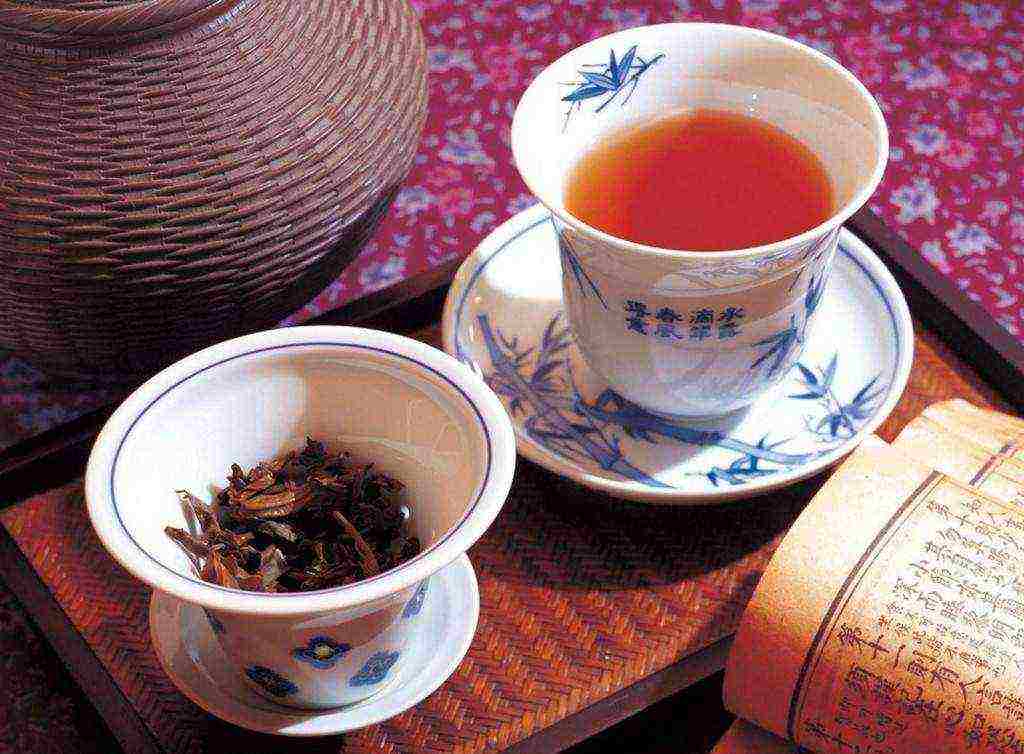
Probably hard to find someone who hasn't tried Chinese tea... This aromatic and invigorating drink is relevant both in hot season and in cold winter. It perfectly quenches thirst, and even hunger, helps to relieve headaches and relieve fatigue, and helps to remove toxins from the body.
There are many varieties and varieties of this drink, but among them there are a dozen "leaders" who are invariably present in the list of the best teas in China. Teas began to be classified after the formation of the People's Republic of China. It was then that this dozen favorites appeared. Which varieties have earned the title of "top ten"?
1. Xihu Longjing
Xihu Longjing - green tea, the first among the leaders. Since its inception, this drink has managed to conquer many people. During the time of Emperor Kangxi (Qing Dynasty), this tea became an offering drink, and later, thanks to Emperor Qian Long, it was named "Imperial Tea". Thanks to its emerald color, wonderful floral taste and unrivaled aroma, the tea has gained the highest reputation. The drink is able to heal and rejuvenate the body, remove toxins and prevent the development of cancer cells. Longjing perfectly tones the body and lifts the mood.
2. Dongting Bilochun
This green tea is famous all over the world. Among the fruit trees near Lake Taihu, Bilochun tea is grown. Crowns of fruit trees, stretching over the tea bushes, allow the tea leaves to breathe the air filled with aromas. Bilochun is harvested when the fruit trees are in bloom, giving the drink its characteristic fruity aroma and flavor. A distinctive feature of the Bilochun variety is its early harvest. The tea is created from the most delicate unblown buds and young leaves. Thanks to this, it is saturated with amino acids and helps to strengthen the body. There are seven varieties of this drink. It has a rich color, aroma and fruity taste. Tea leaves are very fragile and delicate in appearance, covered with villi. Due to the peculiarities of the collection, aroma, taste and color, the drink was named “One tenderness and three freshness”.
3. Junshan Yinzhen
Junshan Yinzhen is an expensive and rather rare yellow tea from Hunan province. It is harvested only once a year - two weeks in the spring. Only young tea buds are used for production. Junshan Yinzhen tea plantations are located on Junshan Dao Island of Dongting Lake. Junshan Yinzhen yellow tea has a deep and velvety taste, with many semi-aromas and semi-shades. In the aroma of this drink, you can catch notes of flowers, melted snow, honey, trees, although the aroma of apricot and prune prevails.
Junshan Yinzhen is able to surprise the most sophisticated tea connoisseur, you just have to try this drink once, and you will always remain its fan.
4. Huangshan Maofeng
This green tea is incredibly light and fresh. When used, it may give the impression of floating above the ground. Maofeng is grown in Anhui province. Not far from the place where this tea grows is Mount Huangshan, hence the name of the drink. Tea leaves are distinguished by their external beauty, each one is about one and a half centimeters long and is rolled up so that its tip is in the middle. The leaves are covered with a white soft fluff. Maofeng is harvested in the early morning by hand in early April. After that, the leaves are sorted and dried. The tea is processed on the same day it is harvested.
The incredibly fresh taste of this drink leaves a sweet aftertaste. Tea is recommended to be consumed with cheddar or goat cheese, seafood, as well as apple or raspberry jam. The drink perfectly refreshes and gives a feeling of lightness.
5. Qi Men Hong Cha
The peculiarity of this red tea is its tart taste, with hints of dried fruits and wine. The aroma of the drink intertwines the smells of honey and cinnamon, with subtle notes of pine. The color of the infusion is ruby-red and is not lost even after several infusions.
The homeland of this drink is Qi Men county in Anhui province. Raw materials for production are harvested in spring and summer, while selecting exclusively young buds with several leaves, which are amenable to withering, rolling, fermentation and drying.
Qi Men Hong Cha is considered the best tea for boosting immunity. Its use promotes longevity. Red tea improves kidney and intestinal function, is useful for low blood pressure and colds. Lotions from this drink are great for treating puffiness under the eyes. Qi Men Hong Cha can be used as an adjuvant for indigestion, the use of the drink soothes cough and relieves sore throat, heals headaches. Since the amount of caffeine in this variety is minimal, it can be consumed even in the evening. Tea will help you relax, warm and soothe.
6. Liuan Guapian
Liuan Guapian is the brightest representative of Chinese green teas. The drink is quite rare, the raw materials for its production are collected in a limited area and in limited quantities. It is grown in the Anhui province of Liu An county and harvested at an altitude of about five hundred meters on the slopes of the mountains, at a temperature of 14 degrees. Harvesting takes place at the beginning of the rainy season. Unlike other teas, the leaves are not used for the production of Liuan Guapian. The middle of each leaf is cut out, the leaf is fried in a pan. During drying, the leaf takes on the shape of a pumpkin seed.
The color of the infusion is light green, transparent. The scent is very strong, fresh and heady. The taste combines astringency, tenderness and sweetness. The exquisite deep taste of this drink is captivating.
The drink helps to raise mood, normalize blood pressure, has antioxidant properties, helps to cope with insomnia and improves vision. On hot days it perfectly quenches thirst and refreshes.
7. Taiping Houkui
Green tea lovers will love this variety. Large-leaf tea, the length of a dry emerald leaf often reaches ten centimeters. The raw materials for tea are collected in the Houken district of Anhui province near Lake Taiping. The plantations are located at an altitude of 600-800 meters above sea level. The manufacturing process takes only one day. In the morning, the leaves are harvested, sorted closer to noon, then dried. The original type of tea is explained by the fact that at one of the processing stages it is flattened by wrapping it in a cloth.
Unsurpassed aroma with light tobacco notes and fresh taste will not leave indifferent fans of this drink. It is very useful to have a cup after physical and emotional stress. Taiping Houkui has all the beneficial properties of green teas: it removes toxins, improves immunity, and has a beneficial effect on the human body as a whole.
8. Xinyang Maojian
Another green tea from Henan province. The gardens where this tea is grown are located at an altitude of 750-800 meters above sea level in an area called "Five Mountains and Two Lakes". To make Xinyang Maojian, only a bud with one or two leaves is taken. One hundred thousand buds are spent on making only one kilogram of tea. Harvesting is done in early spring. Raw materials are processed on the day of collection. Processing includes several stages of frying and several curling, sorting and drying.
The taste of the tea is rich, but at the same time soft, with herbal-nutty and floral notes. Each time you brew it again, Xinyang Maojian's flavor is revealed even more.
Xinyang Maojian has many useful qualities. Drinking the drink slows down the aging process, has a positive effect on the condition of the skin, relieves headaches, cleanses the liver and kidneys, invigorates and improves mood. So it promotes inner calmness and clarity of thought, helps to focus and tune in to work, eliminates drowsiness and gives strength.
9. Tie Guanyin
A very popular elite tea. The most delicious oolong tea, according to connoisseurs. Tie Guanyin is home to Anxi County. Tea leaves of a soft dark color have a sandy green tint and a noticeable sheen. The middle of the leaf is dark green, the edges are reddish.
The light and rich taste of this tea does not become boring. There are floral and honey notes on the palate, depending on the quality. The high content of essential oils allows the drink to be brewed several times without losing aroma and taste.
The raw materials for the production of Tie Guanyin are collected four times a year. They choose more blossoming leaves and take care not to damage them.
The drink rejuvenates the internal organs, improves complexion, with regular use, intestinal polyps are absorbed. In addition, a cup of a fragrant drink raises your spirits, gives clarity of thought, helps communication and bringing people closer together.
10. Da Hong Pao
Da Hong Pao belongs to the oolong variety and grows in the Un mountains of Fujian province. The collection of raw materials is carried out at the beginning of May once a year. The leaves are dried, crumpled and fermented. After roasting, curl and dry to get rid of excess moisture. During the summer, cuttings are cut off, then sorted. At the final stage, the tea is slowly heated over coals. Depending on the degree of roasting and production technology, the taste of this drink may differ. Weak roast gives a more delicate taste, strong - rich, with fruity notes. Tints of chocolate, spice and caramel can be felt. A feature of this variety is its property to change perception, to introduce into a state of euphoria. The so-called "tea intoxication" is observed. With regular use of Da Hong Pao, weight decreases, blood condition improves, aging processes slow down, and the condition of teeth also improves.
As you can see, the selection of teas is quite rich and varied; there is a drink for every tea lover. Despite the fact that each variety differs in its color, taste and aroma, they all have very useful properties for the human body, namely, they strengthen immunity, remove toxins from the body, help lower cholesterol, prevent the development of cancer, have a beneficial effect on the emotional state human, as well as help to reduce weight. And these are not all the beneficial properties of tea. A cup of fragrant drink will not only give you pleasure in taste and aroma, but will also bring great benefits to the body.
In our article, we would like to talk about Chinese tea. Inexperienced lovers of this drink are frightened, first of all, by its variety.It is somehow not very clear where to start and what is better to choose. Therefore, I would like to clarify this issue a little. Let's see what Chinese tea is. We will also discuss its types and main distinctive characteristics, and in as much detail as possible. Of course, there are a lot of varieties of the drink, but we will try to understand the main positions of this issue, without getting into the jungle.
Description and types of Chinese teas
There are many varieties of Chinese tea, as well as classifications of this drink. However, the easiest and most acceptable way to distinguish between teas is to view them in terms of fermentation or color.
It is clear that Chinese tea is grown and harvested in China. In general, the topic: "Chinese tea: varieties, types" is extremely interesting if you delve into the essence of the issue. Many varieties have a long history and tradition.
So, there are such varieties of Chinese tea:
- Green.
- White.
- Yellow.
- Oolong (light and dark varieties).
- Red (we call it black, and the Chinese call it red)
- Black - pu-erh (a mixture of black and green)
- Floral.
Let's take a closer look at each type of drink, as they deserve closer attention. If you understand the nuances, believe me, you will no longer be confused by the hieroglyphs of the names. Chinese tea, types and properties will be clear to you, and you will easily make your choice in the store.
Green tea
There are many varieties of green tea. Imagine that eighteen provinces in China are engaged in the production of this species. The main feature of the green variety production is the processing technology in which the leaf is fermented. Freshly picked tea is dried in the open air. This process is called “killing the greens”. The less time the leaf is dried, the closer its properties are to white. When the tea becomes soft and sluggish, it is thermally processed. This keeps the leaf green and gives the scent of fresh greenery. At the same time, natural medicinal properties and active substances are preserved in tea. Heat treatment can be different, which gives a variety of flavors and shades of green varieties.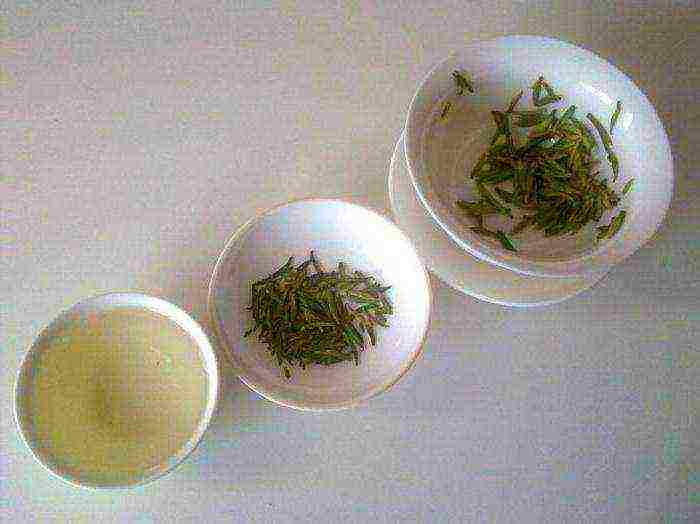
Types of green Chinese tea:
- Fried. The most famous of this type: "Bio Lo Chun", "Long Jing".
- Teas that are dried in a special oven-like equipment. Types: "Taiping HouKui", "Huangshan Mao Feng".
- Steamed. They are steamed and then curled. Teas of this type have a delicate aroma and floral-fruity notes, a mild taste.
After heat treatment, the leaves are shaped. This is done in various ways, which is why some types of tea take on a unique shape. Curling tea leaves is not an easy process. It significantly increases the shelf life of the infusion, which allows you to preserve and improve the properties of the tea. The weakly rolled leaf has the mildest taste. During production, high-altitude varieties are twisted by hand. Processing one portion takes about an hour!
After rolling, the tea is dried. In finished form, it should have a true green color, bright and saturated.
Brewing green tea
You need to be able to properly brew Chinese tea. Its types are different, which means that it is brewed in different ways. You should be aware of this in order to make the most of its beneficial properties. Green varieties are recommended to be poured with water, the temperature of which is in the range from sixty to eighty degrees. And by no means boiling water. The brewing process takes one to three minutes. It should be noted that different types of green varieties withstand from two to six brews. The finished drink has a color range from light green to golden, yellow-green.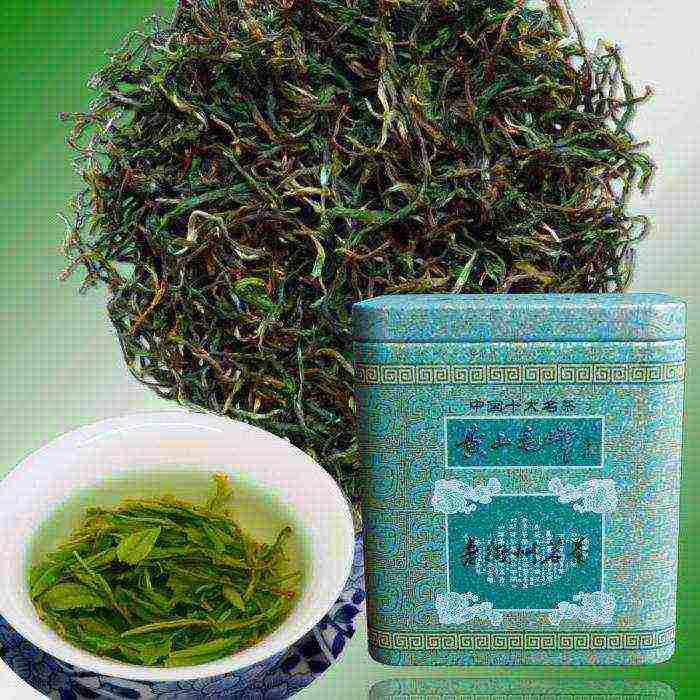
High-quality green Chinese tea (we indicated the types earlier) has a bright aroma, which is dominated by fruit, floral and herbal shades. With prolonged or improper storage, the drink loses both properties and aroma.
Do not forget that it is green varieties that contain a lot of caffeine, a long brewing process can give a bitter taste.Correctly brewed tea, unlike other varieties, has a record amount of vitamins, nutrients and trace elements. Therefore, it is true that the types of Chinese tea and their properties are interrelated.
White tea
Considering the types of Chinese tea (photos of the product are given in the article), one cannot but pay attention to the unique white variety of the drink. It is produced only in Fujian province. During harvesting for white tea, only the youngest buds and half-open leaves, which are still covered with white villi, are selected. They are called white cilia.
White tea has its own special processing. It is only sun-dried and dried. The leaves do not curl, they remain in their natural form. It is important to maintain the correct temperature for processing. Too high can kill the most delicate taste, and too low can make the drink bland. In general, the Chinese believe that since all processing processes are carried out manually, then the mental attitude of the person who works with tea is important, first of all.
In finished form, the white variety does not have twisted tea leaves, it is just a scattering of leaves. They should be grayish green or just green. Remember that white fibers on its surface are an indispensable indicator of the quality of white tea.
Properties of white tea
What properties does white Chinese tea have (types, varieties, description will be given by us below)? White varieties have a cooling effect on the human body, so connoisseurs use it in warm weather. The drink is very light, so you can add a little more tea leaves when brewing than when using other varieties. However, too strong tea will not let you feel the full flavor and aroma. The most vividly and fully flavoring qualities are revealed with a weak brewing of the drink.
Brewed white tea has a pink-yellow or pale yellow color with a characteristic, very bright herbal aroma.
To properly prepare a drink, you need to fill it with water, the temperature of which is about seventy-five degrees. Tea has a specific concentration of essential oils that give it a very refined aroma. Too hot water can ruin the amazing qualities of white tea.
Many people ask themselves a question when buying: "How to choose the right Chinese tea?" Types, names, processing - everything is important here. And there are many nuances to be aware of.
White tea is rather poorly transported and stored; due to very little fermentation, it is picky about storage conditions. Tea Bai Mu Dan ("Bai Mu Dan"), which means white peony, has gained immense popularity. It is produced in the Chinese province of Fujian. The leaves are collected in early spring before they are completely blooming.
For brewing, you need to take two teaspoons and leave for two to four minutes. The drink should have an almond yellow color, a pinkish tint is possible. White tea has a fresh bright aroma with herbal notes. At the beginning of our era in China, white tea was considered the elixir of immortality. I must say that the immortality of the emperor was meant, ordinary mortals could not afford such tea.
The Chinese say that white tea is the most useful, because it undergoes very little processing, which means that almost all vitamins and microelements are preserved in it.
Scientists at the University of Oregon in the United States have confirmed the anti-cancer properties of this drink. In addition, white tea has a beneficial effect on the heart and blood vessels, strengthens the immune system, and is even able to protect against bacteria and viruses.
Yellow tea
The yellow type of tea is produced only in the Chinese province of Huan. Little is known about yellow teas in European countries. For many centuries in a row, it was forbidden to export Chinese yellow tea from the country. The types of this drink were previously consumed only at the imperial court, and later it was drunk by the highest dignitaries at religious ceremonies. In those days, violations related to the tea trade were punished very severely, despite the person's position in society.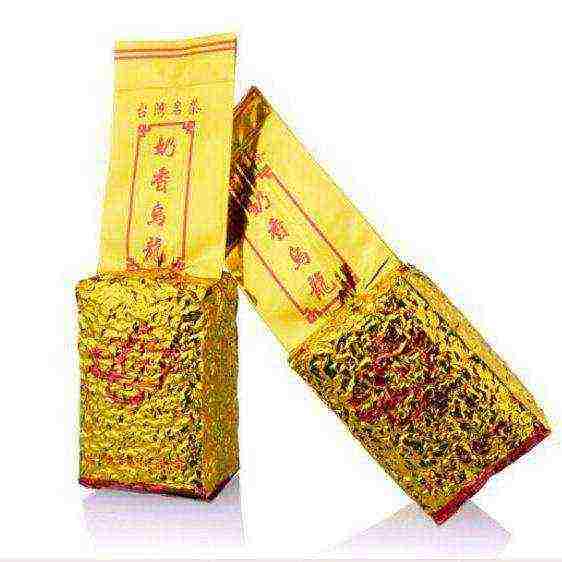
And only in the nineteenth century was it allowed to trade in yellow tea, or rather, to exchange it in Russia for sable furs.Later, China again limited the number and range of exported varieties. In general, the Chinese are very sensitive to their national product. And the yellow type of tea was the first on the list of goods prohibited for export.
Features of yellow tea varieties
In other countries, however, it has not been possible to produce the same type of drink. This is due to the fact that there is simply no necessary raw material. In addition, the production of yellow tea is a very labor intensive process. It only requires the use of manual labor. Under capitalism, entrepreneurs do not take the risk of engaging in such production.
Yellow tea is a lightly fermented species. In terms of properties and appearance, yellow teas can be confused with green teas. However, their production technology is completely different.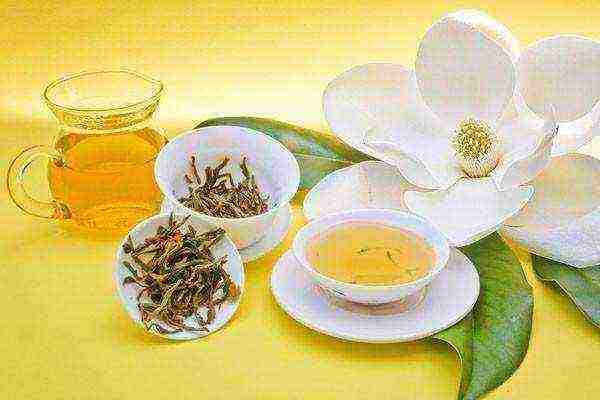
For yellow tea, leaves are taken from a special type of bushes. Only juicy, strong buds are harvested. Imagine that 50,000 kidneys need to be harvested to produce just one kilogram! Yellow teas produce seventy-two hours. This is a special process: for some time the leaves are heated over hot coals, and then wrapped in parchment, which causes the yellowing process. All these procedures start the fermentation mechanism. While the tea leaves languish, all the white pile on their surface burns out. This is another distinctive feature of this species. If for a white variety white villi are an indicator of good quality, then yellow varieties should not have them at all.
Yellow tea is brewed in the same way as green tea. Infused for no more than three minutes. But as for the taste, the yellow variety cannot be confused with any other. It has a pleasant, soft, caressing taste with light notes of astringency. The scent is truly sophisticated and refined. Experts say with confidence that this variety has no equal in terms of velvety and softness. An interesting fact is that, for example, red varieties have a strong aroma that can be easily recognized. But as for the yellow look, its aroma is elusive. It is felt only during tea drinking. Then he quickly disappears and it seems that he did not exist at all. Such is the interesting feature.
Yellow tea is very strong and therefore has aphrodisiac properties. It has an amber yellow color that is similar to the hue of a green beverage. But there is one feature by which varieties can be distinguished. Green tea tends to reflect on the porcelain wall of the cup with a greenish color, but the yellow variety gives a reflection in the form of a pink rim.
Turquoise tea - oolong
In translation, "oolong" means "black dragon", it is also called turquoise. Oolong (tea) got its name from the Wulongjian River, which flows through the Fujian province - the homeland of this variety.
Oolongs are classified as semi-fermented varieties. This is a special kind, it is also considered to be tea perfection. This variety grows very high in the mountains. It is collected by people who know the tea business and pass on their knowledge and skills from generation to generation. Most often, Oolongs are made from sufficiently mature leaves. Once assembled, they are placed in the shade to wither. The process takes up to one hour. Then they are placed on trays made of bamboo and periodically stirred and kneaded. This process is repeated several times until the edges of the leaves turn red and brown. Then they are calcined in the sun for fifteen minutes. Oolongs undergo group curling.
The brewing of such tea depends on the variety. If it is a lightly fermented oolong (Tie Guanyin variety), then it is brewed like green. In general, after cooking, Oolong tea has properties, thanks to which it cannot be confused with other types. A quality drink has a strong floral scent. But the color scheme can vary from a light green hue to golden and red. Oolong is used for the tea ceremony.Only under such conditions is it possible to fully reveal all the properties of the drink.
The variety of oolongs is amazing. Mainland and island varieties are distinguished.
Black tea
We call tea black, but in China it is red. This type goes through a long technological chain. Unlike other types, black tea is fully fermented. First, the leaves are dried, then rolled, and then placed in damp, dark rooms for heating. There it is fermented and takes on its darker hue. Next, the leaves are dried in ovens with streams of dry air.
Black tea is brewed with almost boiling water, and then infused for up to five minutes. The finished drink has a wide range of colors and varied tastes. The black variety has a more resinous smell.
The most famous Chinese black tea (types, names):
- Anhui Qihong.
- "Dianhong".
- "Tsimen Khuncha".
- Isin Huncha.
- Laosong Xiaozhong.
The Chinese themselves do not consume red (black) tea, but it is widely represented on world markets.
Puer
The Chinese call black tea aged for years. The most famous is Puerh. It got its name from the name of the city where it was originally sold. It has a special production technology and is highly fermented.
The leaves are first collected, then dried, rolled and pressed. Fermentation takes place already during storage. After a couple of years of storage, the bitterness leaves and the drink can be consumed. However, in order to achieve real taste and aroma, such tea must be stored for fifteen to twenty years. Naturally, no one waits that much time.
Black tea is brewed only with boiling water.
Bound tea
There is also a very special Chinese tea in the form of a flower. It is also called bound. The fact is that it is manually knitted from expensive green varieties. Sometimes yellow, red and white varieties are added.
However, the main feature of this tea is a very fragrant flower, which is added to the drink. The bound tea looks like a dry bud tied with a thread. It is inside the bud that the flower is hiding. This tea is made only by hand, and therefore every time something interesting and new is obtained. Therefore, there are many options for associated tea.
Instead of an afterword
In our article, we figured out what Chinese tea can be. The types (hieroglyphs on the boxes are not a reason for panic) are so numerous and varied that sometimes you do not know which one to choose. We hope that after reading our article, you will still be able to decide and purchase a suitable product. Better yet, try different options, because each has its own flavor and unique aroma!
Famous teas of China (Chinese 中国 名茶) or Ten famous teas of China (Chinese: 中国 十大 名茶) is a list of the ten most famous varieties of Chinese tea in the world. Contrary to popular belief, it is not rigidly fixed, and differs depending on the originator and place of compilation. The following table is compiled on the basis of twenty similar lists, it contains only those varieties of tea that are mentioned in these lists more often than others (at least ten references out of twenty, with any configuration of the lists).
Ten famous teas of China
About the origin of tea varieties
Traveler and folklorist Rusty Quill traveled around China for a long time, collecting folk legends about teas that are among the ten most famous. Among other things, he managed to record the following legends and myths.
Longjing
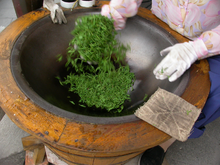
According to legend, a severe drought raged in the mountainous regions of Lion's Peak in Hangzhou in 250 AD. Tea cultures that year craved every drop of moisture that would fall from the sky. Alas, the absence of even a drop of the precious liquid jeopardized the very existence of tea. To prevent this, the wandering monk set off along narrow mountain paths to summon the dragon who lived by the springs that filled their wells.The monk prayed that the dragon would bring rain to the people in order to save the most precious thing - the tea harvest. The dragon, being generous, and probably also wanting to drink tea, satisfied the monk's request with a heavy rain and the spring has never dried up since then. To this day, the same spring feeds the tea bushes near Lion's Peak, and the dragon never again felt thirsty for his beloved Long Jing, which means "Dragon's Well".
Bilochun
Many centuries ago, Bi Luo Chun was known as Xia Sha Ren Xiang (吓 杀人 香), which means "Astounding Scent." Legend has it that tea pickers walked among the bushes near the garden city of Suzhou, filling their baskets with a particularly good harvest of delicate tea. Bathed in mist from the mountain, the tea shoots and buds ripened with the scent of peach, apricot and plum, planted here and there among the tea bushes. The tea plantation workers soon filled their baskets to capacity, as they were not going to miss a single escape from this beautiful tea harvest, and rammed as much as they could into their tunics. Some say they stole for themselves. Warmed by the warmth of the body and the warm spring sun, the fresh tea began to give off a rich aroma. Many were amazed at the smell of tea.
Later in the late 17th and early 18th centuries, Emperor Kang Xi visited Taihu Lake in Zhejiang Province. The best examples of this tea were presented to him. The emperor was struck by the aroma and purity of the tea and asked for its name. "Striking scent" was the host's reply. The Emperor contemptuously replied that such a name for this treasure would be vulgar and offensive, and not suitable for such an astounding tea. He demanded that the unused leaves be brought to him for inspection, after which he stated that a more appropriate name would be Bi Luo Chun, which means "Green Snail Spring", since the tea was collected from the source at Bi Lo Peak ("Green Snail" ) The Dongting Mountains and the rolling shape of the curled tea leaves looked like tiny green snails.
Tie Guan Yin
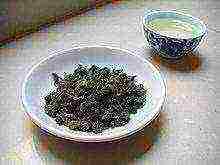
Many centuries ago, in Fujian province, an old villager walked around his farms, enjoying the singing of birds and trickles of streams gushing nearby. Every day he passed an ancient abandoned temple. At the sight of this once beautiful temple in this form, his heart was filled with deep sadness, but he did not have the means to repair it. Once he decided that at least he could sweep and clean the temple with incense, and he did so twice a month.
In the center of this temple stood a statue of Guanyin, sometimes referred to as the Iron Goddess of Mercy. As each time the villager burned incense in the temple, the statue seemed less and less cracked and crumbled. One day, many years after he began caring for the temple, Guanin appeared to him in a dream. She was so moved by the villager's devotion to her temple that she prompted him to look into the caves behind the temple to find the treasures left there for him. He was instructed to share this gift with others in the same way that he shared his time and efforts with her.
The villager searched for this cave for several hours, before he found a small gap in which only one tea sprout lay, which he turned into a magnificent tea bush. The tea produced from this bush, after brewing, became a golden brown liquid with various aromas and sweetish tastes. Word spread about this wonderful tea and Fujian province became famous for its finest Te Guanyin oolong tea.
Maofeng
The Yellow Mountains of Anhui Province are home to Yellow Mountain Fluffy Peak tea. Soaring rocks rush up to the clouds as far as the human eye can see, with rich fertile soil underfoot, cool air, fog and rain to cool the air. The scent of orchids surrounds it all as soon as the sun begins to peek out from behind the clouds. This is what can be seen on the Yellow Mountain - or Huang Shan. Like many of the surrounding mountains of Mountainous China, Yellow Mountain has its own legend, based on everyday tragedy, of course.
A young man and a beautiful young girl from a tea plantation were in love with each other, but the local tyrant enslaved her as a concubine. She fled, and soon learned that the tyrant, in jealousy, had killed her beloved. When she found the body of her lover, thrown high in the mountains, she cried over him and cried until she turned into rain, while the body of her beloved sprouted into the ground into a tea bush. This is how the legend explains that the area where this tea grows is covered with clouds and is humid here all year round, and why the Yellow Mountain gives delicious Huangshan Maofeng tea.
Baihao
Legend has it that Emperor Huizong was so fascinated by his love for white tea Baihao ("White-haired") and in his desire to drink its ideal brew, he so neglected the affairs of state of his empire that he missed the invasion of the Mongol hordes.
Puer
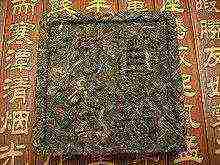
Pressed Puer Briquette
The history of Pu Er ("Village in the Mountains") tea dates back to the Eastern Han Dynasty (AD 25-220). According to legend, the seeds of the tea plant used to grow Puer were donated to the people of China by Zhuge Liang, the prime minister of Shu during the Three Kingdoms. He is also known by the nickname "Tea Forefather". Zhuge Liang taught the people of southern Yunnan the art of picking and making tea. It is believed that the six legendary tea mountains located north of the Lincang River were named after the six things left behind by Zhuge Liang. Yul (copper gong), Manchi (copper python), Manchuan (iron brick), Yi Ban (wooden plate), Geden (leather stirrup), and Mansa (seed bag).
In the Qing Dynasty (1644-1911), Puer was so popular that more than 100,000 people were attracted to growing tea on a mountain near the city of Simao. Pu-erh is known for its healing properties, including being the most famous hangover cure.
Sources of
- ↑ Lim Li Kok. The Ten Famous Teas in China // Origins of Chinese tea and wine. - 2nd ed .. - Singapore: Asiapac Books Pte Ltd, 2005. - P. 14,15. - 150 p. - (Chinese culture series). - ISBN 981-229-369-8.
- ↑ Ling Wang. Appendix 3. Famous Chinese Teas // Tea and Chinese culture / Edited by Luo Tianyou, Xu Rong. - Baijing: Long River Press, 2005 .-- P. 182 .-- 183 p. - ISBN 1-59265-025-2.
- ↑ (1937) "China's Tea on Decline // Famous" I. D. " Products (eng.) ". The China monthly review (J. W. Powell) (80-81): 492.
- ↑ Tea // Appendex 3. Chinese Food and Drink // Information China: the comprehensive and authoritative reference source of new China (English). - Oxford; New York: Pergamon Press, 1989. - Vol. 3. - P. 1417. - 1621 p. - (Countries of the world information series). - ISBN 0-0803-4764-9.
- ↑ Quill, Rusty... Dragonwell (Long Jing) (eng.), Tea Legends - The 10 Famous Chinese Teas, Squidoo. Retrieved August 8, 2011.
- ↑ Quill, Rusty... Green Snail Spring (Pi Lo Chun) (eng.), Tea Legends - The 10 Famous Chinese Teas, Squidoo. Retrieved August 8, 2011.
- ↑ Quill, Rusty... Iron Goddess (Ti Kuan Yin) Tea Legends - The 10 Famous Chinese Teas, Squidoo. Retrieved August 8, 2011.
- ↑ Quill, Rusty... Yellow Mountain Fur Peak (Huangshan Maofeng) Tea Legends - The 10 Famous Chinese Teas, Squidoo. Retrieved August 8, 2011.
- ↑ Quill, Rusty... White Fur Silver Needle (Bai Hao) (eng.), Tea Legends - The 10 Famous Chinese Teas, Squidoo. Retrieved August 8, 2011.
- ↑ Quill, Rusty... Pu-erh (Pu-er: Village of Cove), Tea Legends - The 10 Famous Chinese Teas, Squidoo. Retrieved August 8, 2011.

